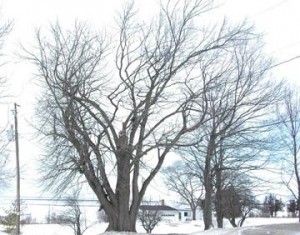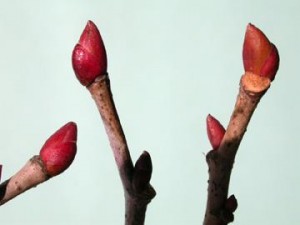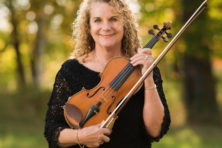Door to Nature
- Share
- Tweet
- Pin
- Share
This has always been one of my favorite times of the year to enjoy the “bare bones” beauty of the deciduous trees. Watch for a clear colorful sunset, grab your camera and you will be rewarded with some superb skyline shows of various trees silhouetted against the colorful western sky.
Some of the most beautiful tree lines in our area growing along boundaries of old stone fences contain many towering Basswoods, also referred to as Lindens in Europe. Seen from a distance they often appear very dark and resemble tall fountains. It’s quite common for some of these majestic trees to have several trunks forming one main crown.
The largest American Basswood in North America grows in Pennsylvania and has a circumference (measured at 4 ½ feet above the ground) of a little over 23 feet, and a height of 89 feet. Our state record, found in Dane County, has a circumference of 19 feet and a height of 55 feet. The biggest Basswood we have measured to date in Door County, several miles west of Little Sturgeon in sight of the bay, has a circumference of 18 feet and is 62 feet tall. We are quite sure that a larger one does exist and hopefully will be discovered.
Quite a few of the Basswoods growing in our south woods are terribly misshapen due to crowding and perhaps also to very shallow soil. They have developed as though they could never make up their minds over the direction in which to grow. Some are downright grotesque, but interesting as well.
Study the history of this unusually fine tree and you’ll be amazed at its importance to people throughout time. American Indians of this region made excellent binding material and ropes from the tree’s inner bark, which has incredibly long and tough fibers. This so-called “bast” led to its common name of bastwood, which quite naturally through the years was unwittingly corrupted to Basswood.
The rope was said to be softer, easier on the hands and equally as tough as some of the modern ropes made from jute and other natural fibers. Asian relatives to our Basswood tree are used to produce jute, which in turn is made into ropes, burlap and gunny sacks.
When it comes to some unusually fine qualities of its wood, that’s another thing. Even though the wood is unquestionably soft, light, weak and somewhat brittle, it has very little grain and consequently carves or whittles magnificently. Put a really sharp tool to a block of Basswood and the resulting surfaces will be unusually smooth and capable of taking paint or stain extremely well. Plenty of people have been fooled into thinking that the nicely stained and varnished wood they were looking at was Black Walnut. Technically, Basswood is considered to be one of the soft hardwoods, and the difference between the texture and “feel” of Black Walnut and Basswood isn’t very great.
One of my prized possessions is an old pair of wooden shoes carved out of Basswood by a Dane over 100 years ago and given to my mother’s parents for a wedding present. They were mounted on a wooden plaque containing a good luck saying and, after many years ended up, minus the plaque, gathering dust on one of the rafters in my folks’ basement. Eventually I rescued them, stained and varnished them, and often fondly caress them for old time’s sake.
Years ago there was great hope in Europe that an excellent substitute for chocolate could be derived from the fruits and flowers of Linden, furnishing a paste which in texture and taste closely resembled chocolate. Unfortunately it did not store well and decomposed rather quickly. According to the literature, all of those attempts involved the use of the European species of Linden or so-called “lime” tree, the same genus but different species than our American Basswood. Perhaps attempts should be made in this country using American species, of which several exist.
One of the most famous avenues in the world, Unter den Linden, in Berlin, Germany, is lined with Lindens, as is the avenue at Trinity College in Cambridge. Basswoods frequently outgrow other broadleaved trees, and for that reason, might be considered as specimen shade trees for your front yard. Some tree nurseries today also carry a few interesting varieties of Basswoods or Lindens which very nicely could be planted along your long driveway, a private “Unter den Linden” lane!
Walk into a typical eastern Wisconsin woods in July and you may suddenly notice an indescribably pleasant, gentle perfume flowing into your nostrils. From overhead comes a steady, soft humming sound signaling without words or voice the type of tree under which you are standing, a Basswood. Bees have been attracted from a considerable distance to the ambrosial nectar of these huge flowering “towers.”
Early spring is a perfect time of the year to inspect and admire some of the buds of a Basswood, appearing for all the world like miniature, plump, deep red hearts. Count yourselves lucky if somehow you can enjoy the beauty, cool shade, fragrant flowers, buds, excellent Basswood honey, imposing tower-like stature, lovely winter silhouette and all else a “bastwood” tree has to offer during the cycle of a year. We strongly concur with the bees. Here is a honey of a tree!






